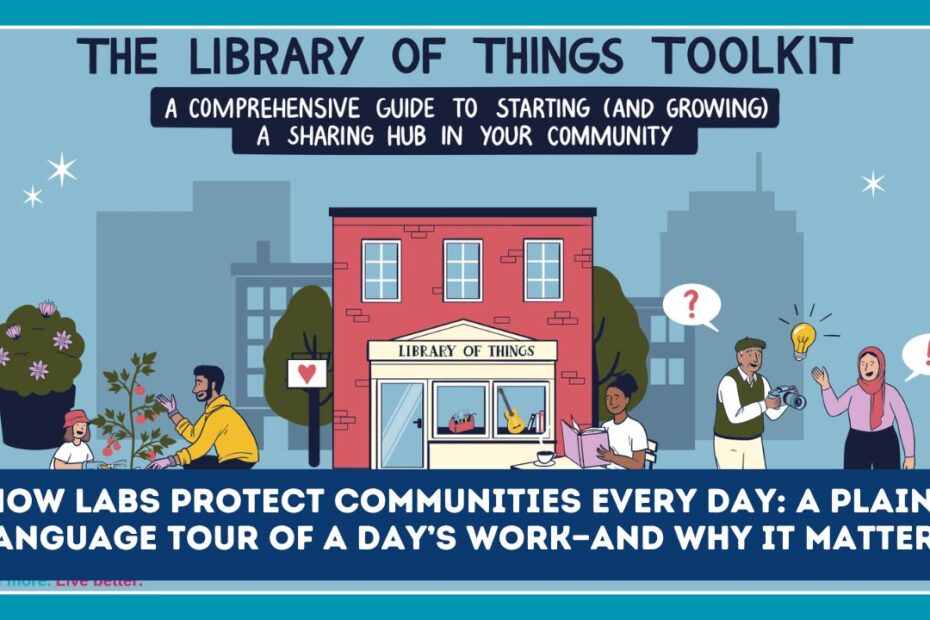When most people think about healthcare, they picture doctors and nurses. But behind almost every diagnosis is a laboratory team working quietly to keep the community safe. This plain-language tour shows what a lab does in a typical day—no technical procedures, just who’s involved and why it matters.
What a Lab Actually Does (in simple words)
A medical laboratory turns samples (like blood, swabs, and water tests) into trusted information that helps people get the right care at the right time. Labs also spot outbreaks, watch for drug resistance, check water and food safety, and alert the community when something unusual is happening.
Key idea: Without accurate and fast lab results, treatment is slower, costs are higher, and public health risks can spread silently.
The People Behind the Results
Here are the roles you’ll find in many labs. Different labs may use different titles, but the purpose is similar.
- Specimen Couriers: Move samples safely and quickly.
- Accessioners (Data Entry): Match each sample to the right patient and test.
- Phlebotomists: Collect blood with care and calm.
- Medical Laboratory Technologists/Scientists: Run instruments, review results, and spot red flags.
- Microbiologists: Identify germs and check which medicines can kill them.
- Pathologists: Doctor-experts who interpret complex results and guide tough cases.
- Quality Manager: Makes sure the lab stays accurate, reliable, and audit-ready.
- Biosafety Officer: Protects staff and the community by enforcing safety rules.
- LIS/IT Specialist: Keeps the Laboratory Information System and interfaces humming.
- Customer Service/Call Center: Helps clinics understand results and timelines.
- Supply/Inventory Lead: Ensures reagents and kits don’t run out.
- Operations Lead/Manager: Balances workload, staffing, and turnaround times.
Quick Reference: Who Does What & Why It Matters
| Role | What They Do | Why It Matters |
|---|---|---|
| Accessioner | Links each sample to the correct patient and test in the system. | Prevents mix-ups so results go to the right person. |
| Lab Technologist | Runs analyzers and checks if numbers make sense. | Delivers accurate results that doctors can trust. |
| Microbiologist | Finds the germ and its drug sensitivity. | Guides the right antibiotic, reducing resistance. |
| Pathologist | Reviews complex cases and advises clinicians. | Improves decisions for serious conditions. |
| Quality Manager | Tracks errors, trains staff, and audits processes. | Keeps the lab safe, consistent, and compliant. |
| Biosafety Officer | Ensures safe handling and waste disposal. | Protects staff and the wider community. |
| LIS/IT | Maintains systems and result delivery. | Prevents delays and data errors. |
A Day in the Lab: Plain-Language Timeline
Early Morning: The City Wakes, the Lab Is Ready
- Couriers bring in samples from clinics and collection centers.
- Accessioners scan and check each sample. They make sure names and barcodes match.
- Quality checks start the day: instruments are warmed up and controls confirm everything reads correctly.
Why this matters: If the day starts accurate, the whole day stays reliable.
Mid-Morning: Peak Flow, Peak Focus
- Technologists load samples onto analyzers for common tests (like blood counts or chemistry).
- Microbiology starts culture plates and checks overnight growth from earlier samples.
- Customer service answers questions: “When will this be ready?” “Can you add a test?”
Why this matters: This is when turnaround time and clear communication keep clinics on schedule and patients on track.
Afternoon: From Numbers to Action
- Abnormal results get a second look. If a result is critical, the lab calls the clinician and asks for a read-back to confirm the message was heard correctly.
- Pathologists review complex patterns and advise on next steps.
- Public health flags: unusual clusters (like many positive flu tests) are noted and shared through proper channels.
Why this matters: Quick, accurate alerts can save lives and slow outbreaks.
Evening & Night: The Quiet Engine
- Night shift keeps the system moving for emergencies and hospital inpatients.
- Inventory is checked; supplies are reordered before they run low.
- IT/LIS runs backups and monitors connections so results flow to electronic medical records by morning.
Why this matters: Care is 24/7, so the lab must be too.
How Labs Protect the Community (Beyond Individual Patients)
- Faster treatment, fewer complications: Reliable results guide the right therapy sooner.
- Outbreak detection: Labs spot patterns across many samples that a single clinic can’t see.
- Antibiotic stewardship: Knowing which drugs work helps prevent antimicrobial resistance.
- Environmental safety: Public health labs test water, food, and air to prevent wider harm.
- Emergency readiness: In fires, floods, or epidemics, labs shift quickly to priority testing and clear communication.
- Equity in care: Standard lab methods reduce the role of bias in decision-making by focusing on measurable data.
Communication: The Secret Superpower
Great labs don’t just test—they communicate clearly.
- Two identifiers for each patient (e.g., name + date of birth) to avoid mix-ups.
- Critical value calls with read-back so nothing is misunderstood.
- Plain-language comments attached to results (e.g., “Sample may be diluted; consider recollection”).
- Shared dashboards for turnaround times, pending tests, and contact points.
- Respect for privacy: Results are protected; only the right people can see them.
Bottom line: Better communication means fewer delays, safer care, and less stress for families.
Safety Without the Jargon
You may hear terms like quality control, validation, or biosafety level. In simple terms, they mean:
- We checked our tools today and they work properly.
- We proved the method is reliable before using it on real people.
- We protect everyone—patients, staff, and the community—by handling materials safely and disposing of waste correctly.
What You Don’t See (But Benefit From)
- Training and drills so staff can handle rare events.
- Audits and accreditation to keep standards high.
- Data security to keep your information private.
- Contingency plans (backup power, extra suppliers) so testing doesn’t stop.
How You Can Help Your Lab Help You
- Bring a valid ID and any doctor’s order to collection.
- Ask if you need to fast or stop certain medicines before a test.
- Keep your contact details updated so you can be reached quickly.
- Be patient with turnaround times—quality takes focus.
- Say “thank you”—lab teams are people too!
Conclusion: Quiet Work, Big Impact
Every day, labs turn small tubes and swabs into answers that guide care, protect neighborhoods, and inform public health. The people inside—couriers, accessioners, technologists, microbiologists, pathologists, quality and safety teams, and IT—work in sync so that results are accurate, fast, and clear. You may never see their faces, but their work touches every clinic visit, every emergency, and every community. When labs are strong, everyone is safer.



